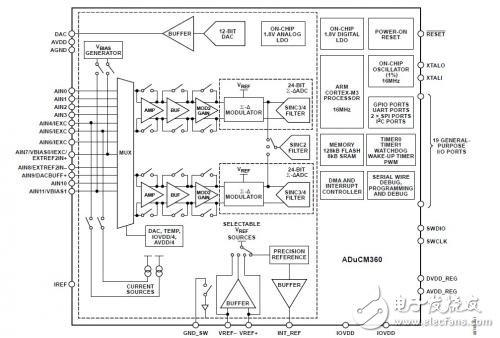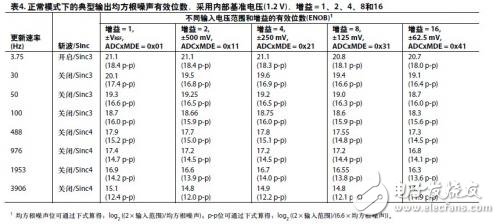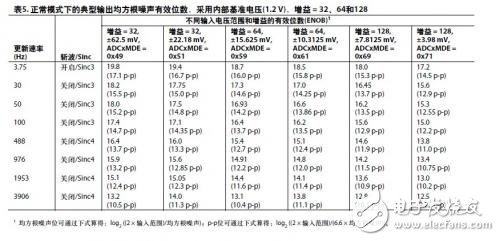The ADuCM360 is a fully integrated 3.9 kSPS, 24-bit data acquisition system from ADI that integrates a dual-core, high-performance multi-channel analog-to-digital converter (ADC), 32-bit ARM Cortex-M3 processor, and Flash/EE memory on a single chip. In wired and battery-powered applications, the ADuCM360 is designed to interface directly with external precision sensors. The ADuCM361 integrates all the features of the ADuCM360, but it has only one 24-bit ADC (ADC1).
The ADuCM360/ADuCM361 comes with an on-chip 32kHz oscillator and an internal 16MHz high frequency oscillator. The high frequency oscillator is relayed by a programmable clock divider that produces the processor core clock operating frequency. The maximum core clock speed is 16 MHz; this speed is not limited to the operating voltage or temperature.
Functional block diagram
Figure 1. Functional Block Diagram of ADuCM360
Root mean square noise resolution of ADC0 and ADC11.2 V Internal References Tables 2 through 5 provide the rms noise specifications for ADC0 and ADC1 with an internal reference (1.2 V). Tables 2 and 3 list the rms noise values ​​for different gain and output update rates for the two ADCs. Table 4 and Table 5 list the typical output rms noise effective bits (ENOB) for the two ADCs in normal mode with different gain and output update rates. (The number in parentheses indicates pp ENOB)


1 ADCxMDE = 0x49 sets the gain of the PGA to 16 and the modulator gain to 2. A modulator gain of 2 is achieved by adjusting the sampling capacitor in the modulator. ADCxMDE = 0x51 sets the gain of the PGA to 32 and the modulator gain is turned off. ADCxMDE = 0x49 is slightly louder, but supports a wider input range.
2 If AVDD < 2.0 V and ADCxMDE = 0x51, the input range is ±17.5 mV.
3 ADCxMDE = 0x59 sets the gain of the PGA to 32 and the modulator gain to 2. A modulator gain of 2 is achieved by adjusting the sampling capacitor in the modulator. ADCxMDE = 0x61 sets the gain of the PGA to 64 and the modulator gain is off. ADCxMDE = 0x59 is slightly louder, but supports a wider input range.
4 If AVDD < 2.0 V and ADCxMDE = 0x61, the input range is ±8.715 mV.
5 ADCxMDE = 0x69 sets the gain of the PGA to 64 and the modulator gain to 2. A modulator gain of 2 is achieved by adjusting the sampling capacitor in the modulator. ADCxMDE = 0x71 sets the gain of the PGA to 128 and the modulator gain is turned off. ADCxMDE = 0x69 is slightly louder, but supports a wider input range.
6 If AVDD < 2.0 V and ADCxMDE = 0x71, the input range is ±3.828 mV.


P3.91-7.82 Transparent LED Display
Features:
*Ventilated light
*Free air conditioning heat saving energy
*Environmental protection- it uses only a third of the power of a conventional Led screen
* Convenient installation High compatibility
* Nova MSD 300 sending card and Nova A5S receiving card
* High debugging brightness and no damage to gray scale, achieving the debugging technology for nice image.
* Passed the TÃœV,FCC,ROHS,CE cetification.
Our company have 13 years experience of led display and Stage Lights , our company mainly produce Indoor Rental LED Display, Outdoor Rental LED Display, Transparent LED Display,Indoor Fixed Indoor LED Display, Outdoor Fixed LED Display, Poster LED Display , Dance LED Display ... In additional, we also produce stage lights, such as beam lights Series, moving head lights Series, LED Par Light Series and son on...
Application:
* Business Organizations:Supermarket, large-scale shopping malls, star-rated hotels, travel agencies
* Financial Organizations:
Banks, insurance companies, post offices, hospital, schools
* Public Places:
Subway, airports, stations, parks, exhibition halls, stadiums, museums, commercial buildings, meeting rooms
* Entertainments:
Movie theaters, clubs, stages.
Transparent LED Display,Transparent Led Display,Transparent Poster Led Display,Led Screen Panel
Guangzhou Chengwen Photoelectric Technology co.,ltd , https://www.cwledpanel.com
